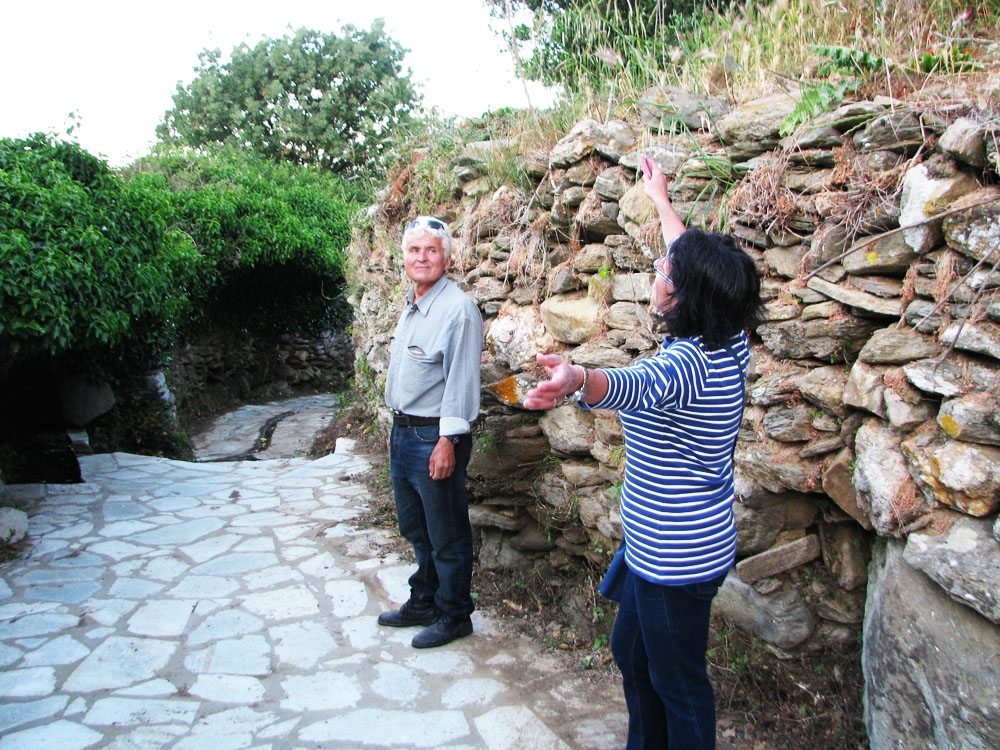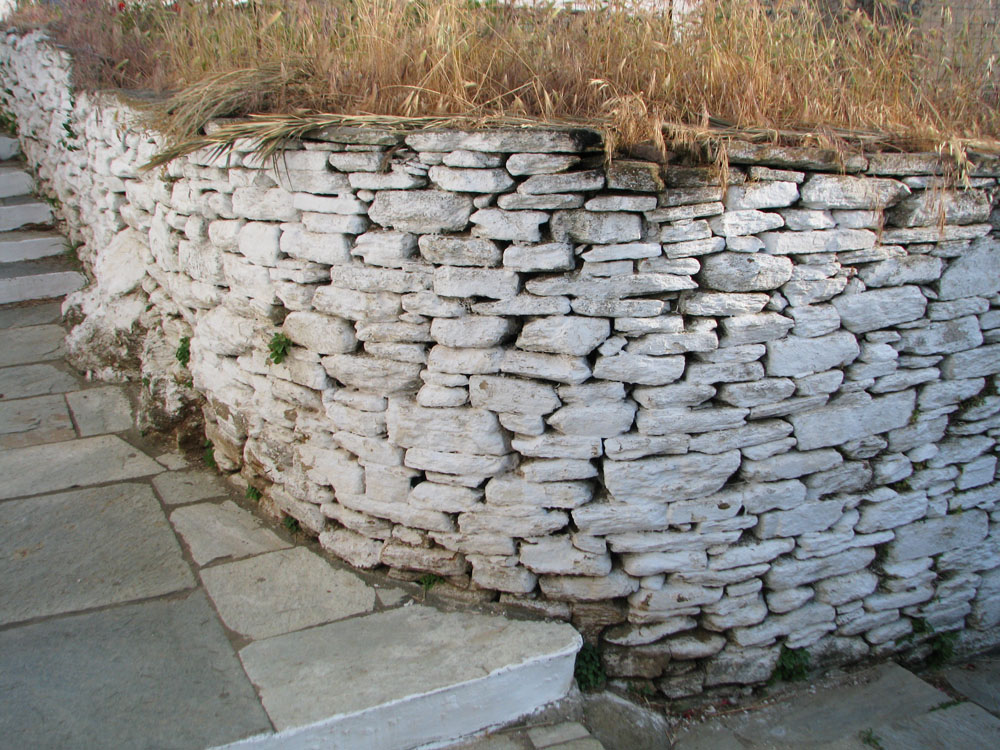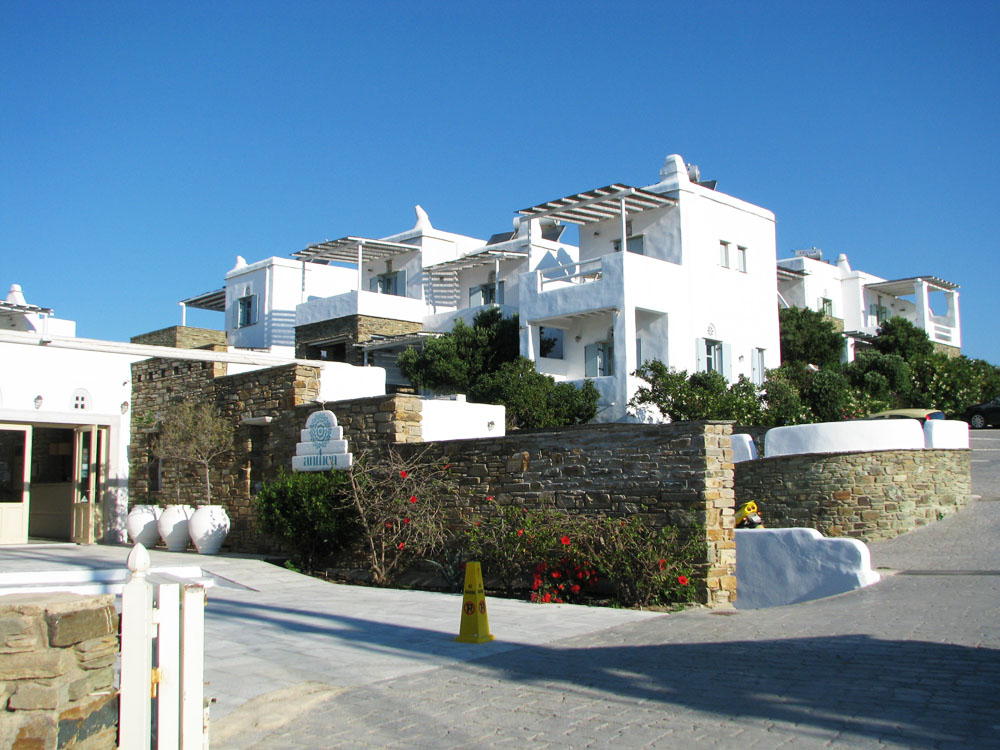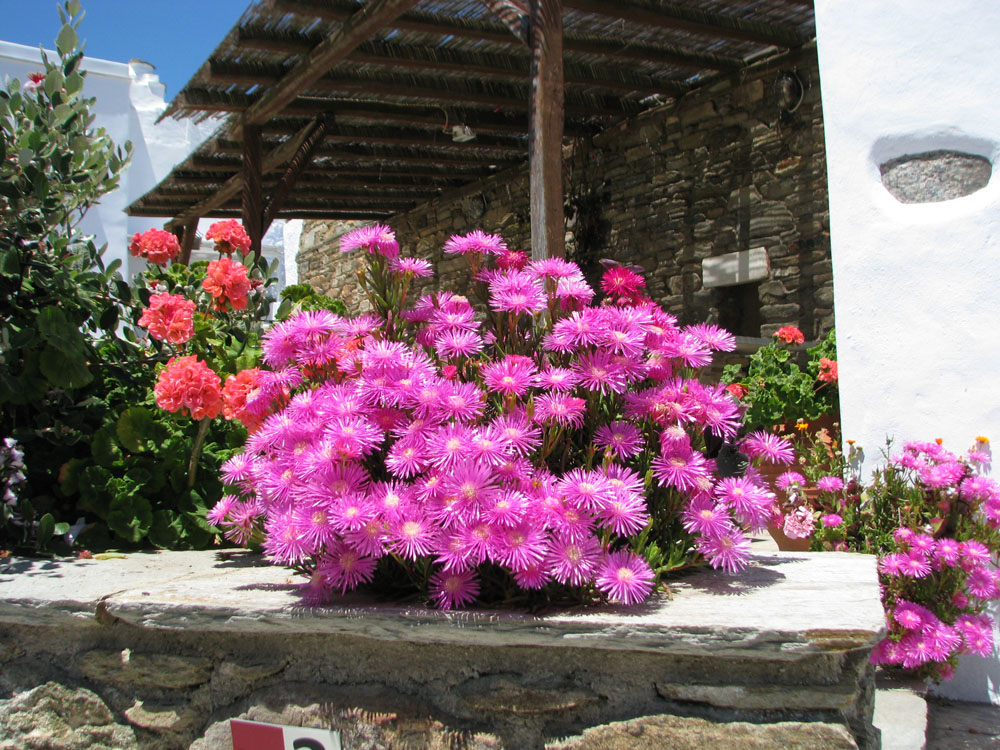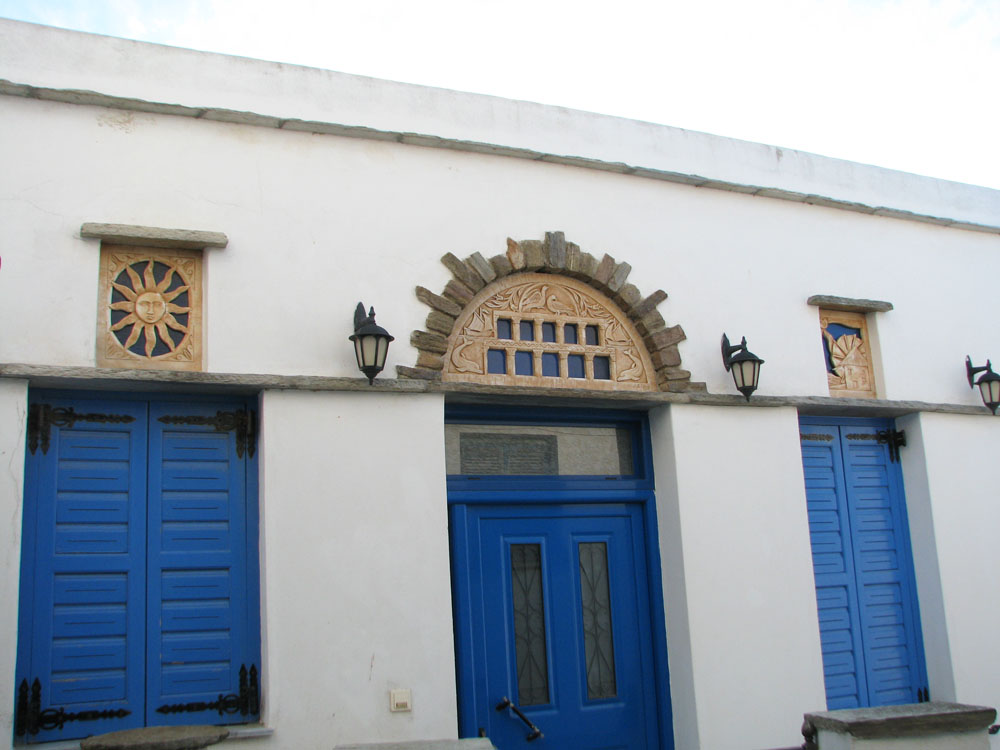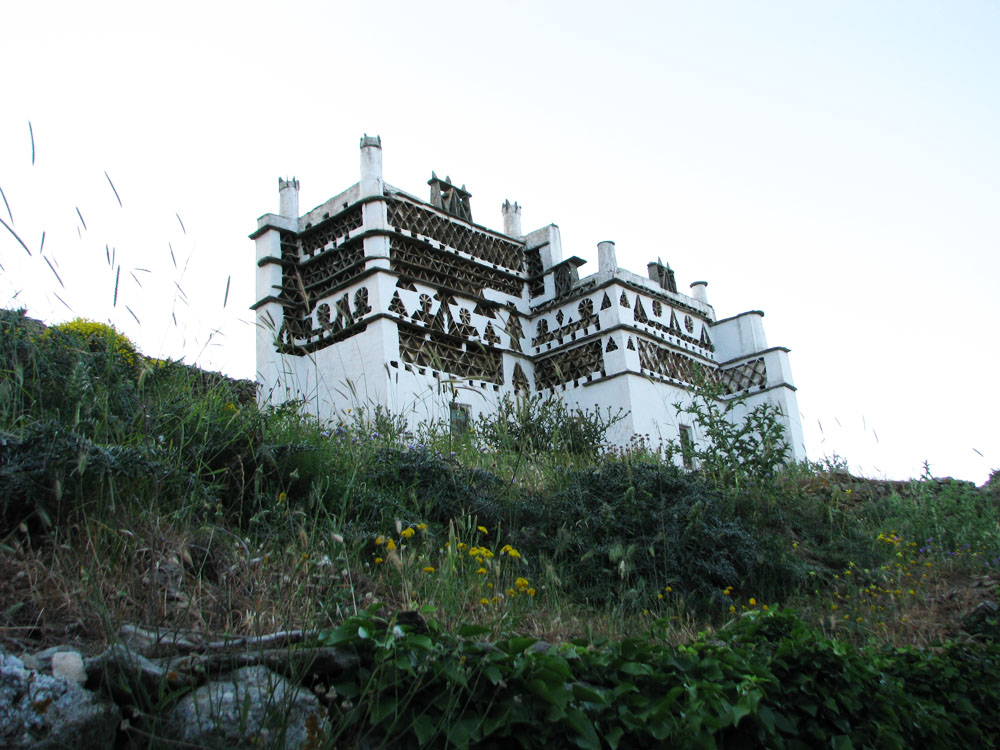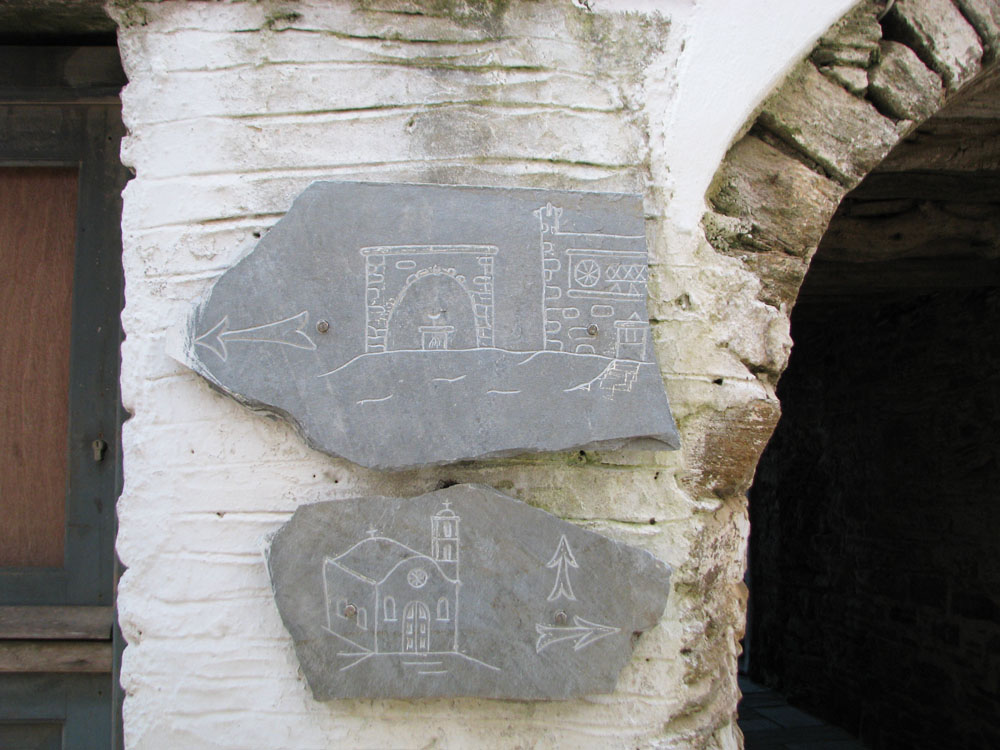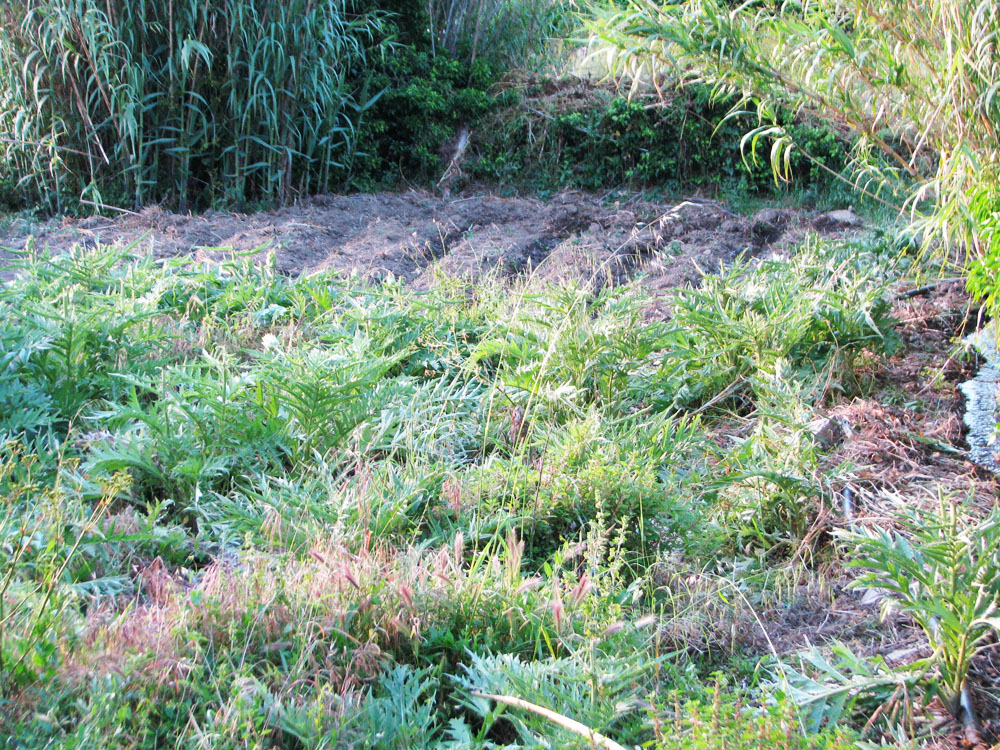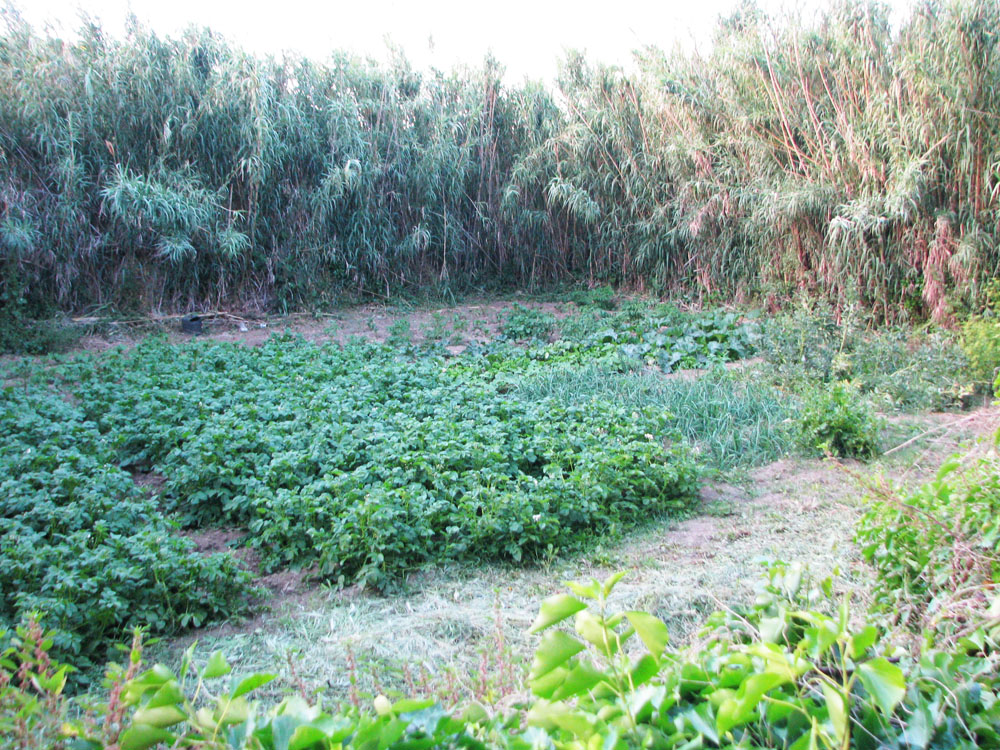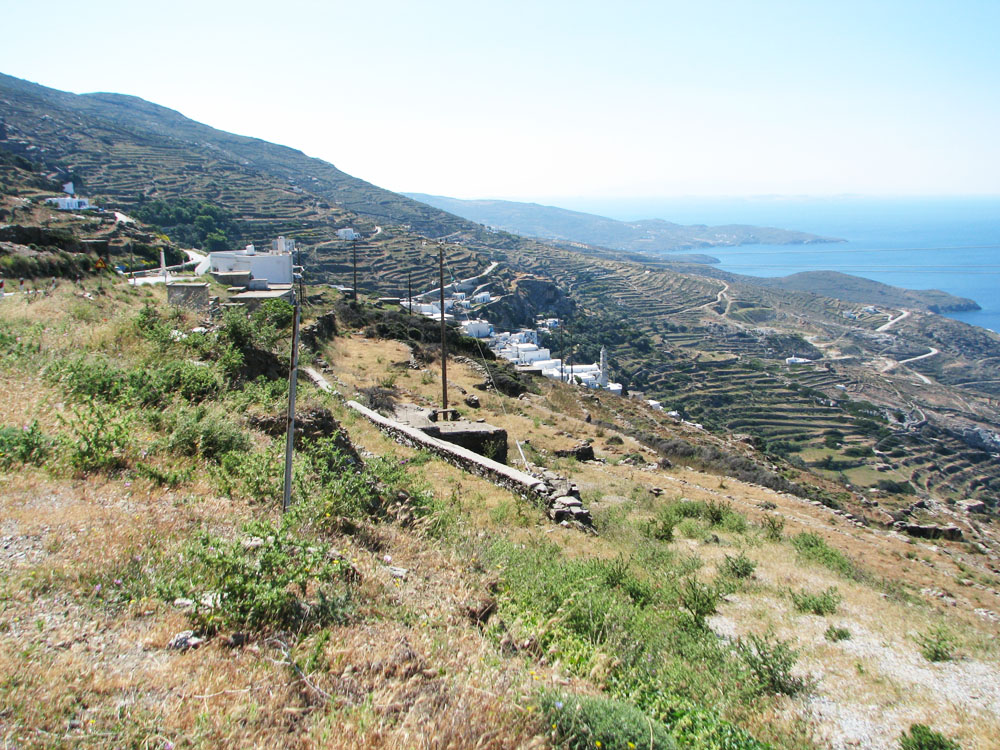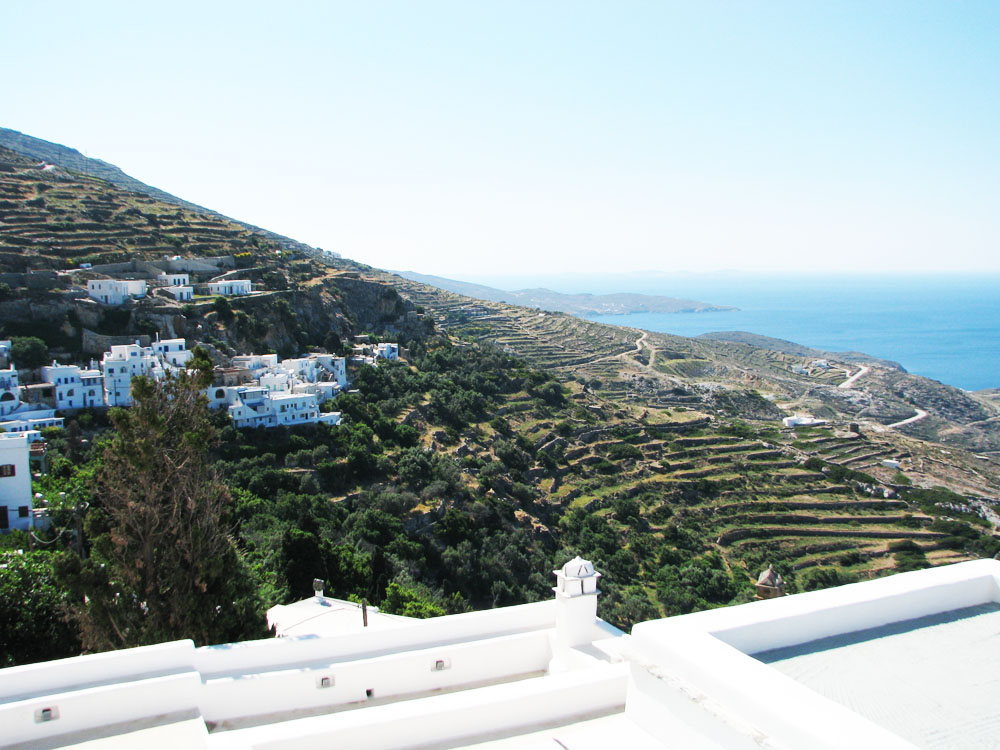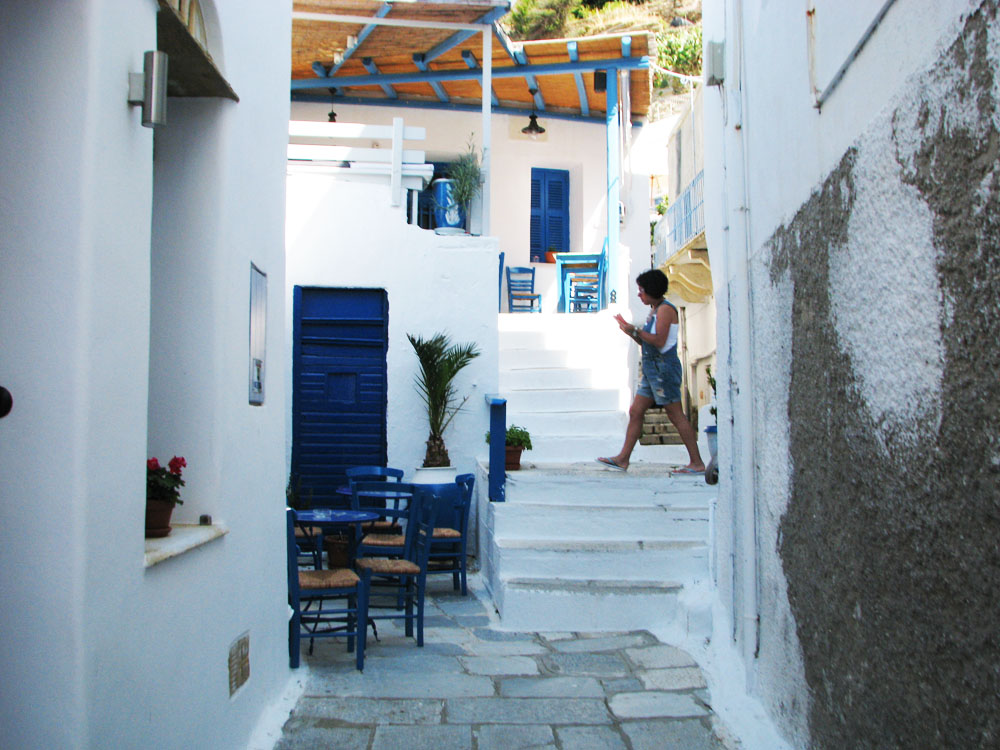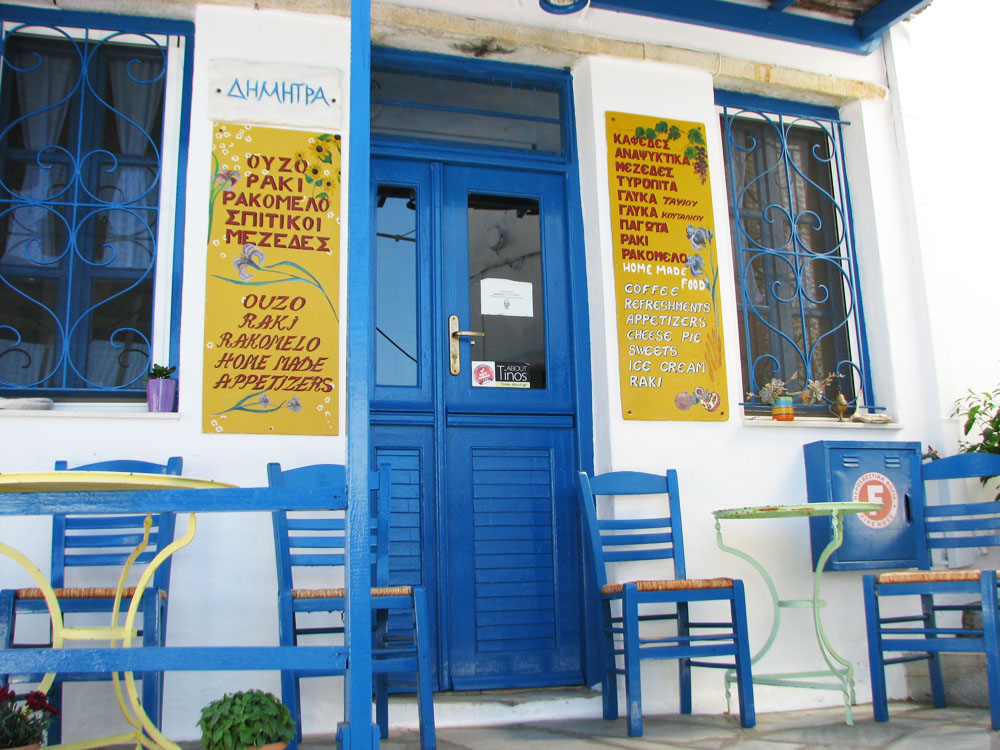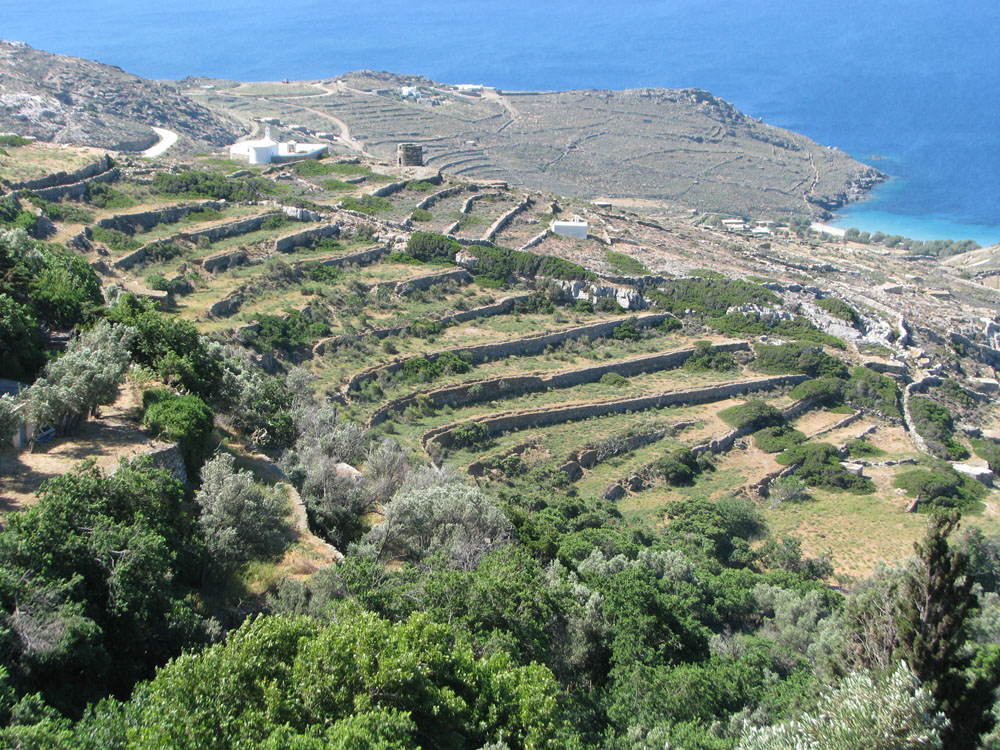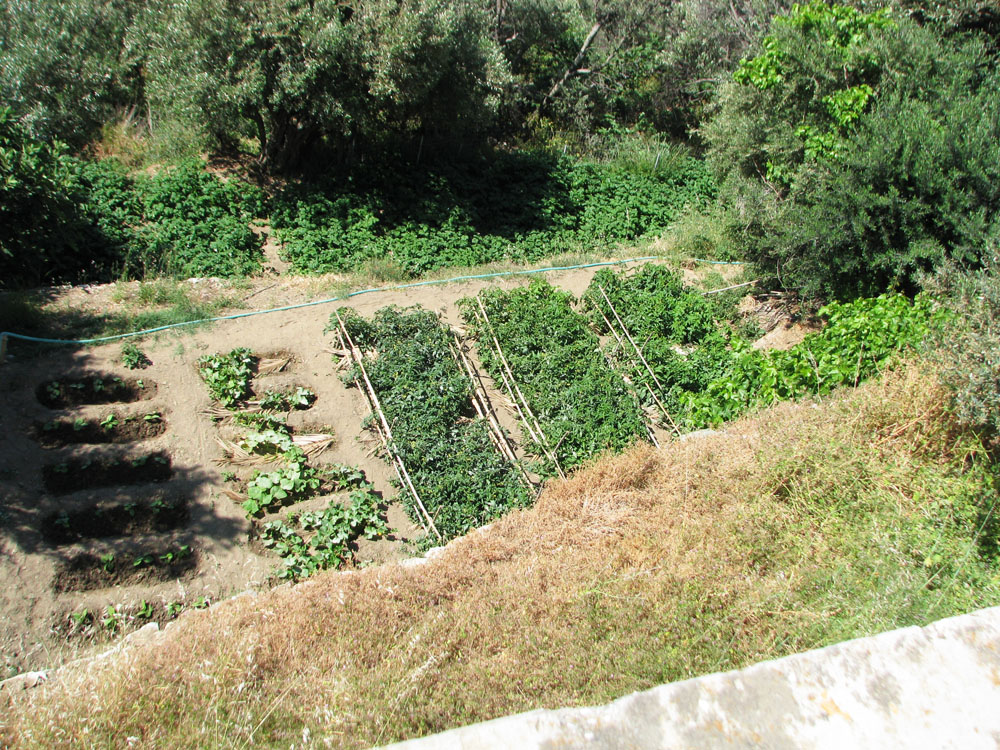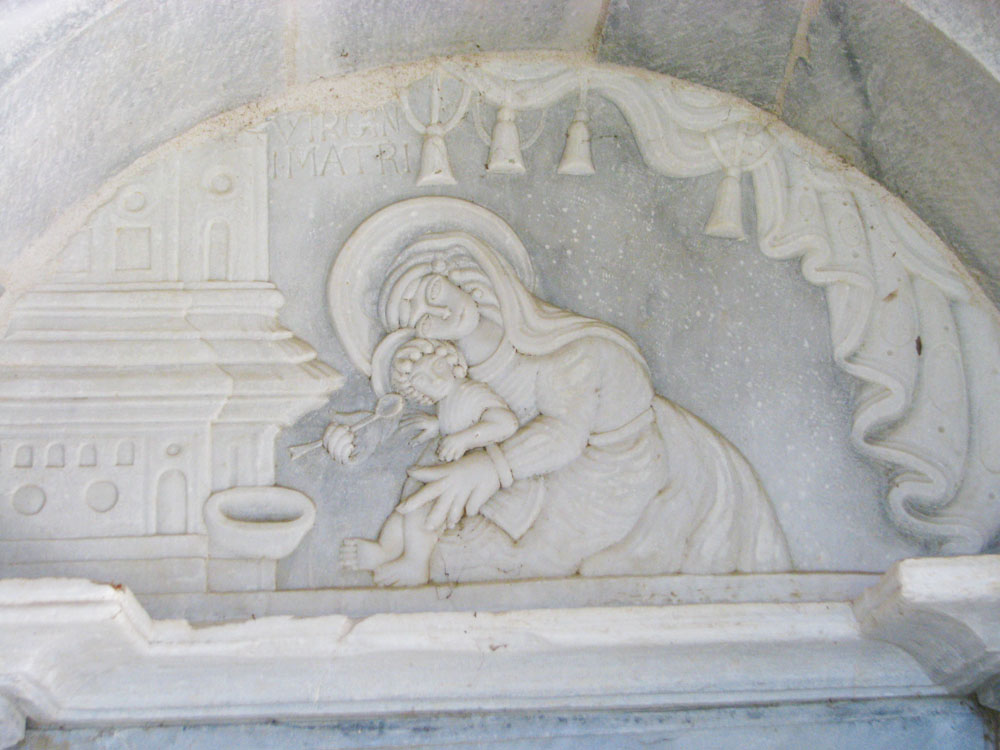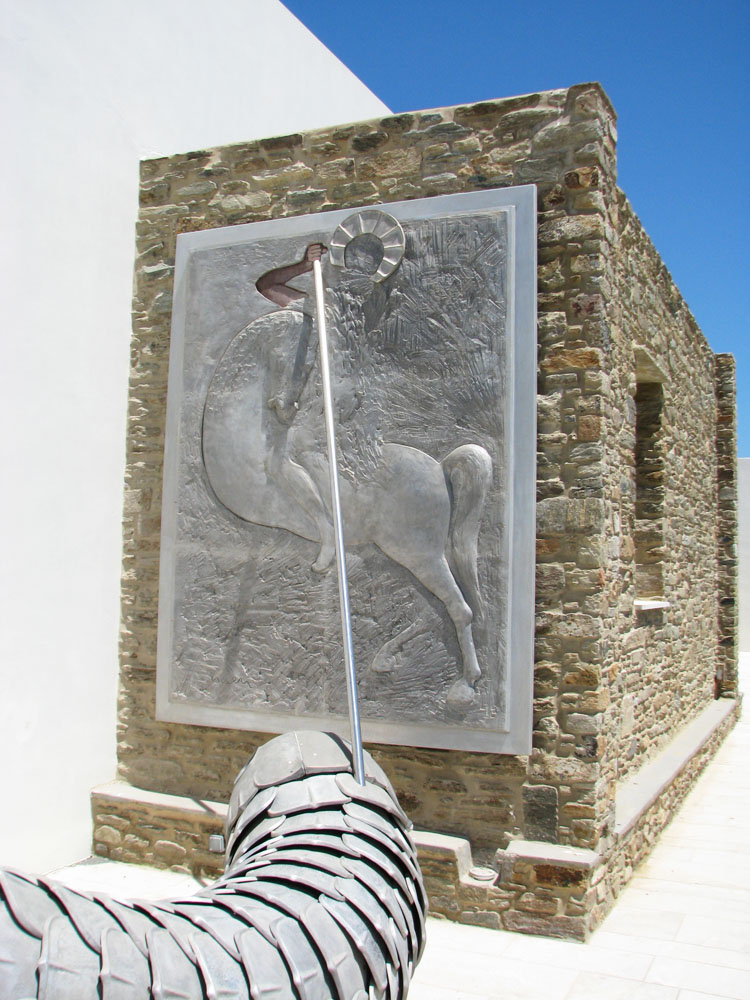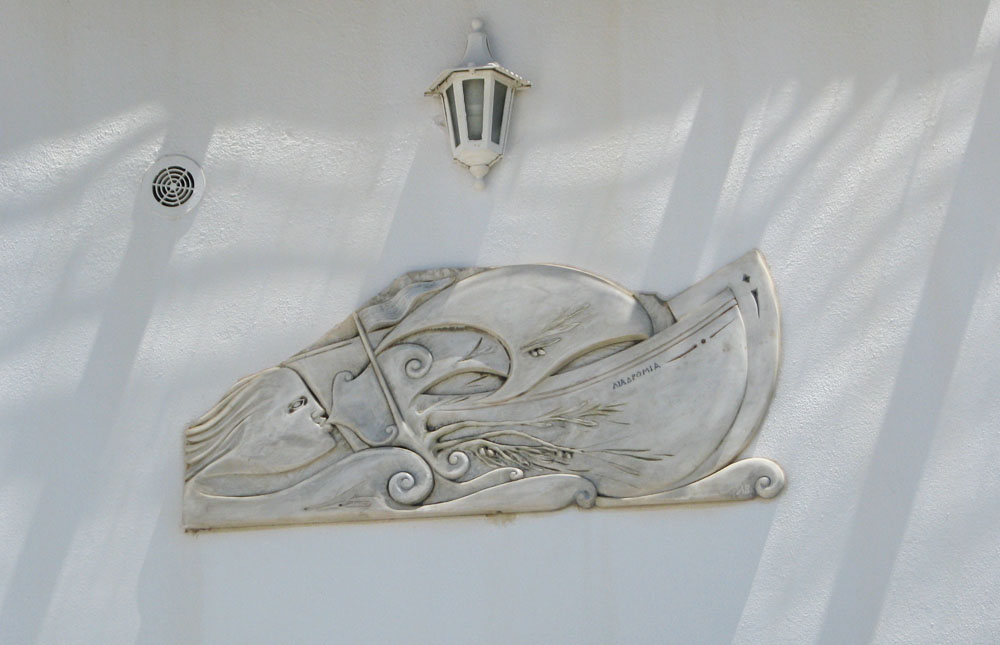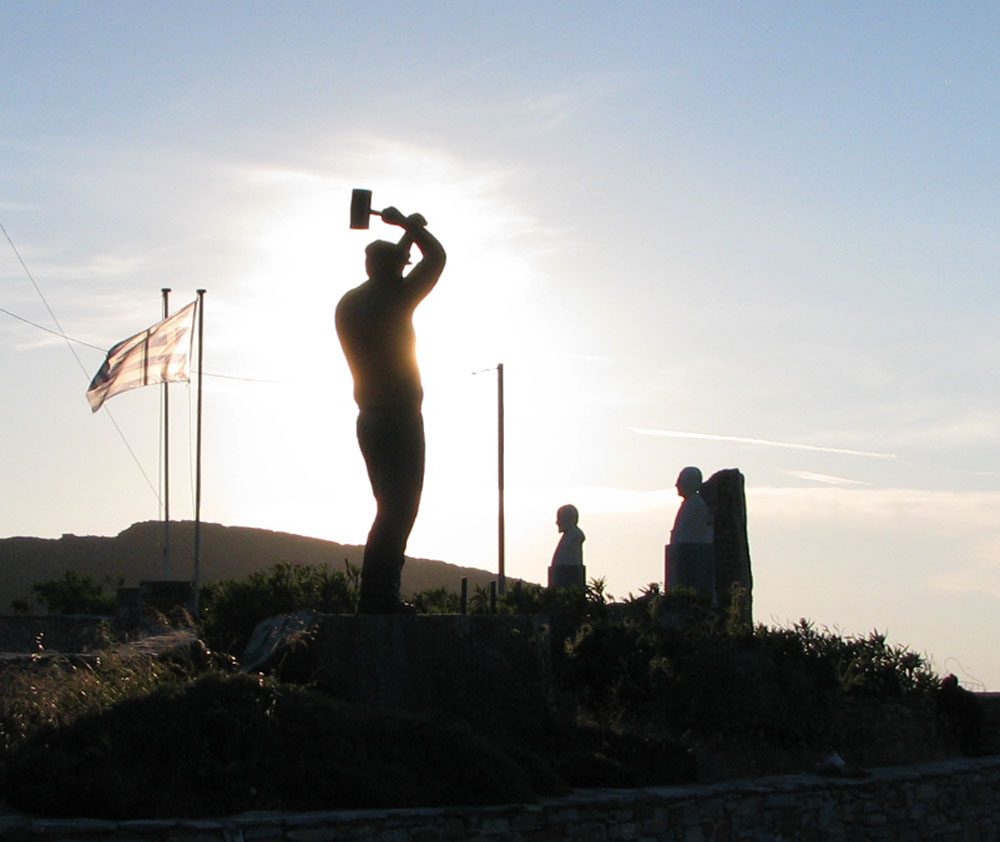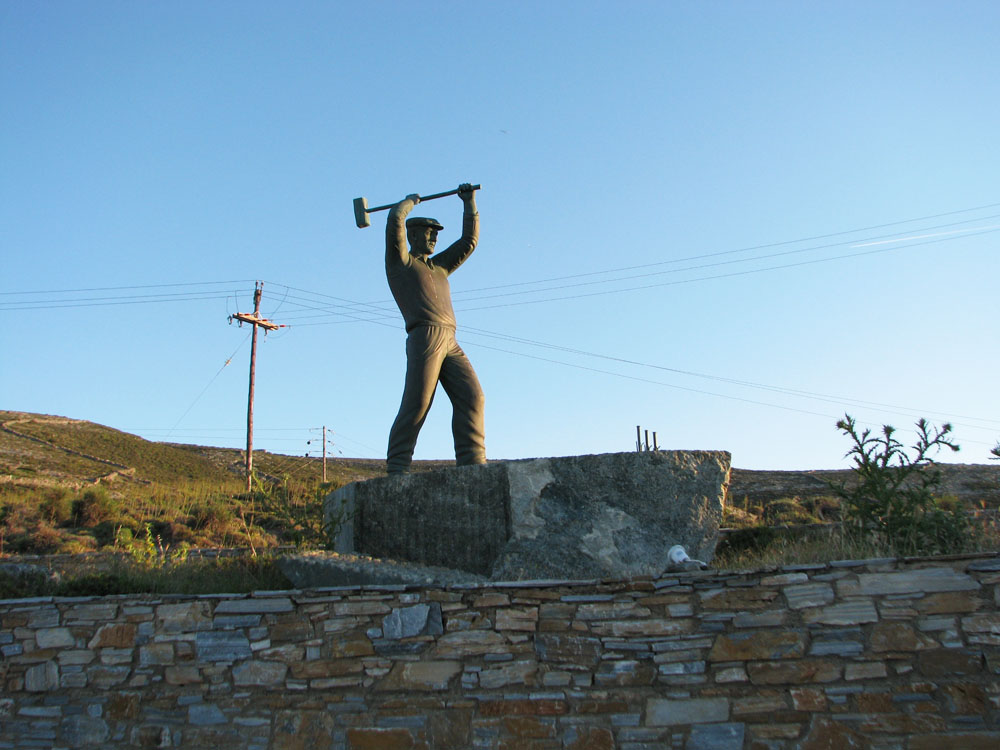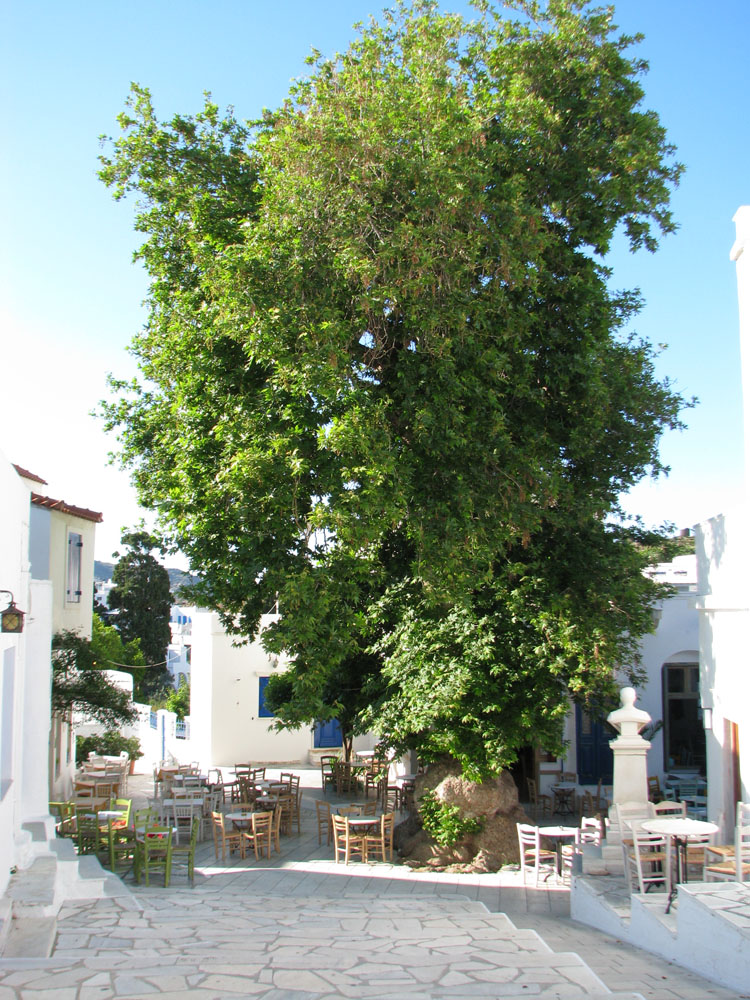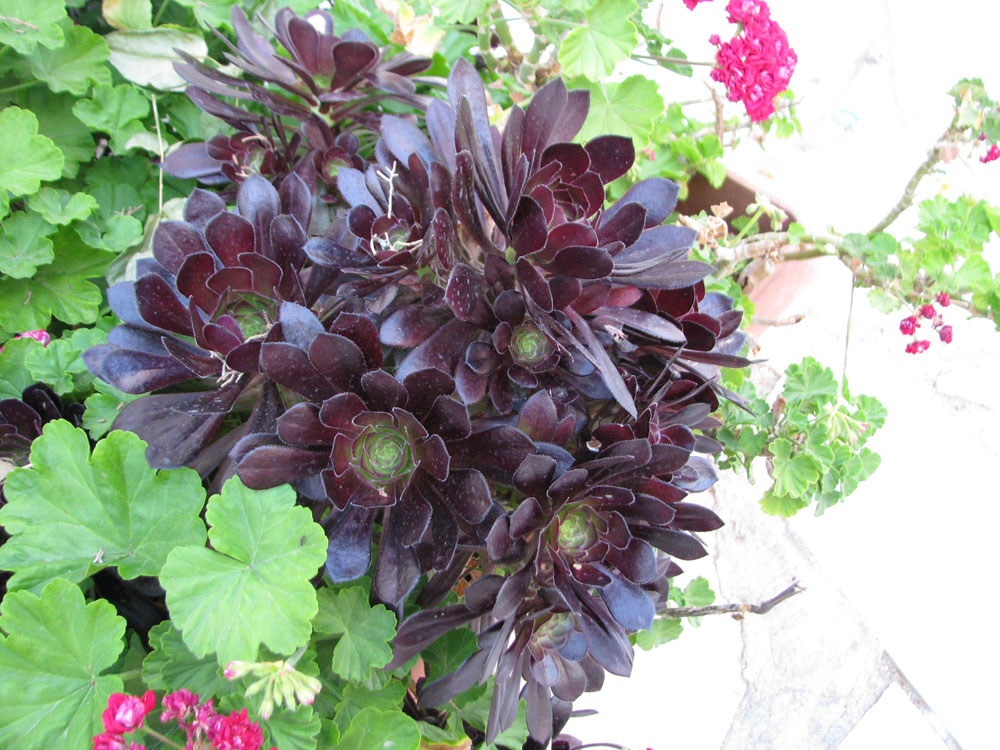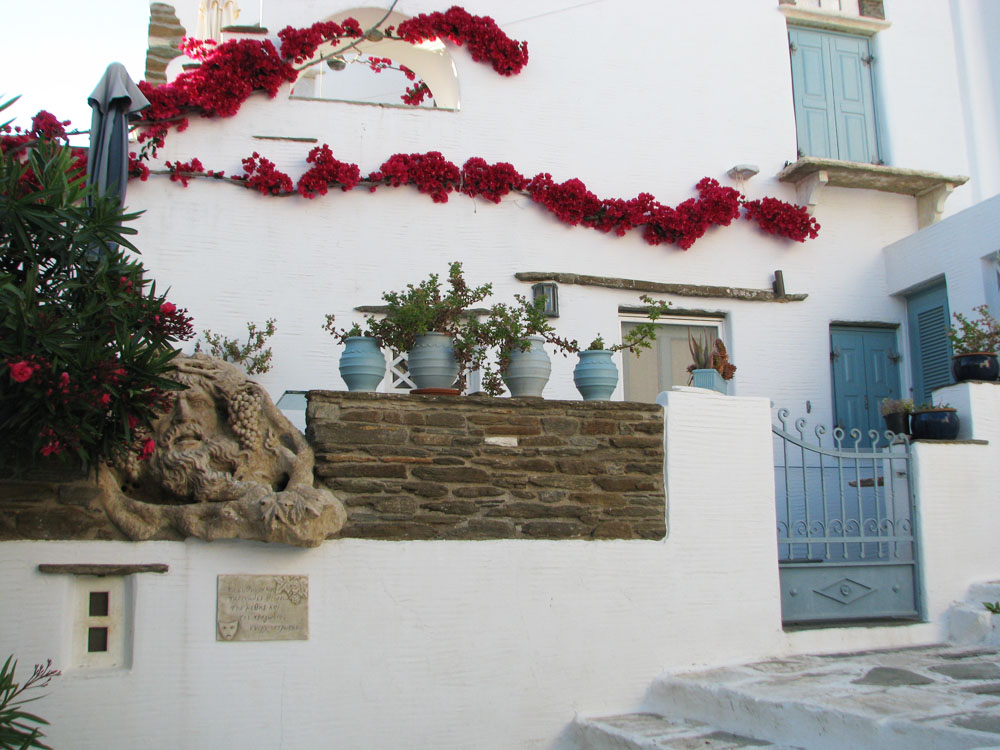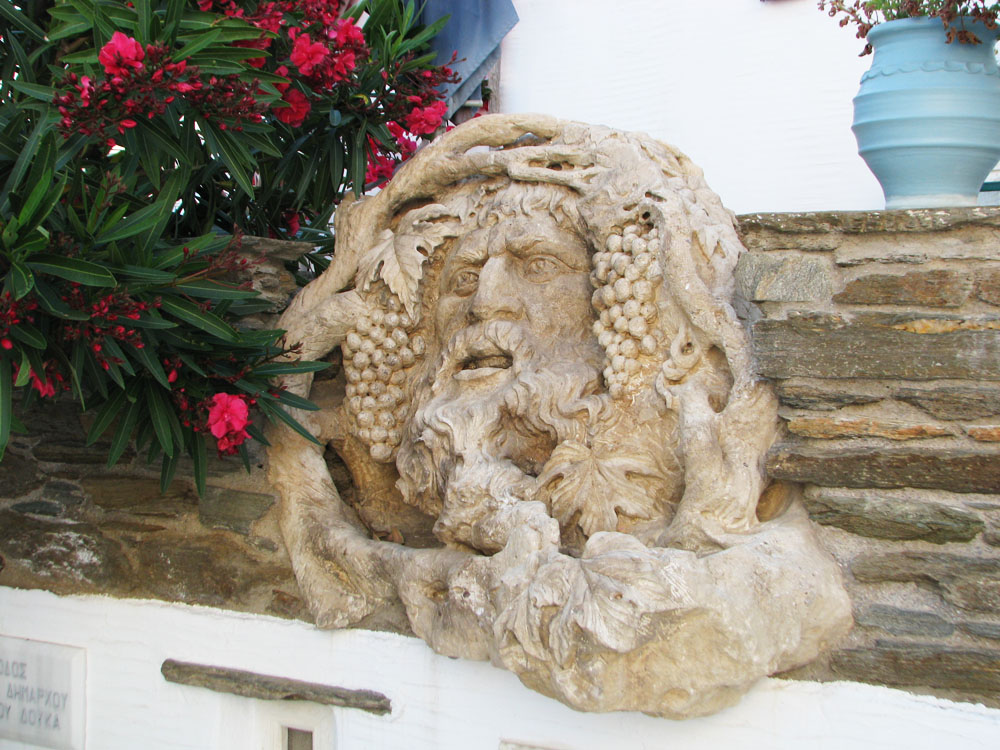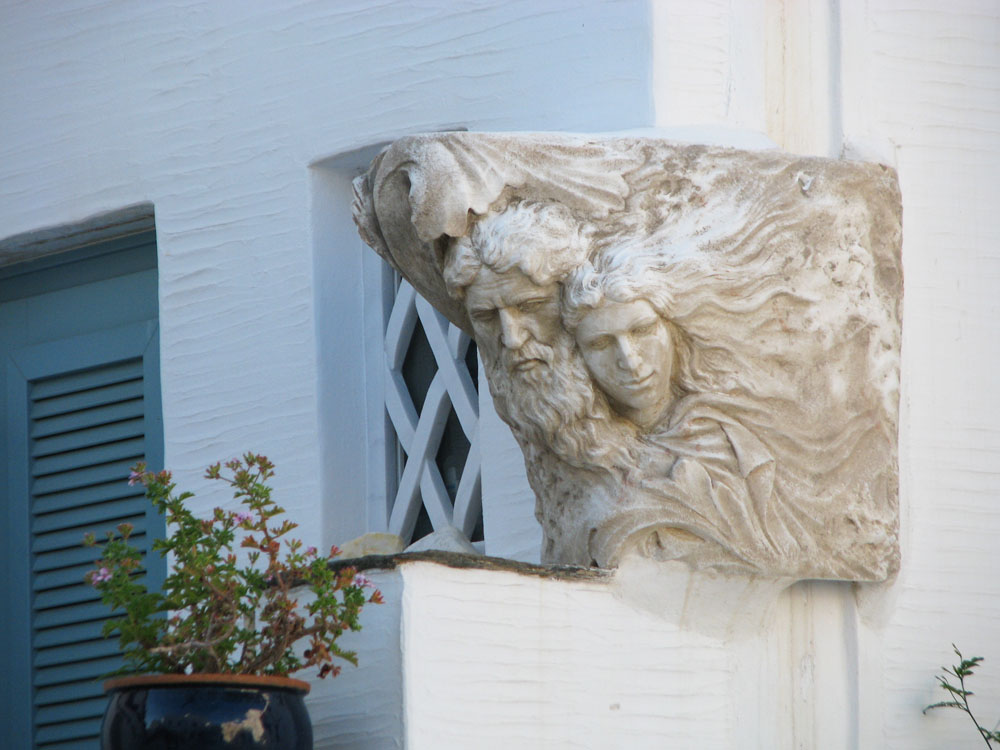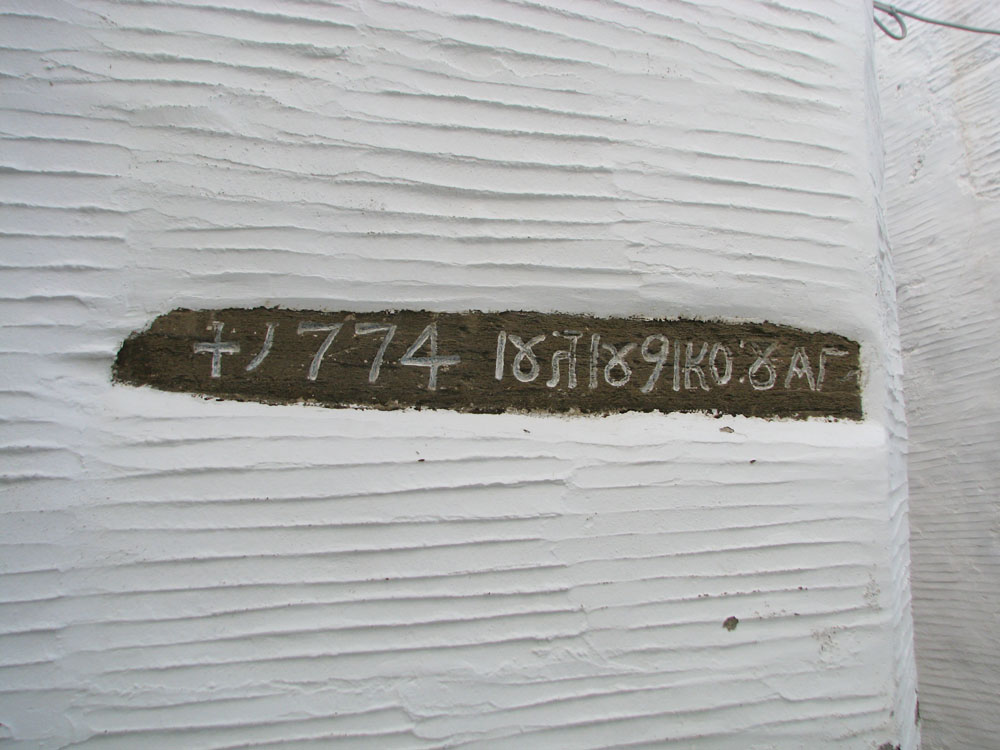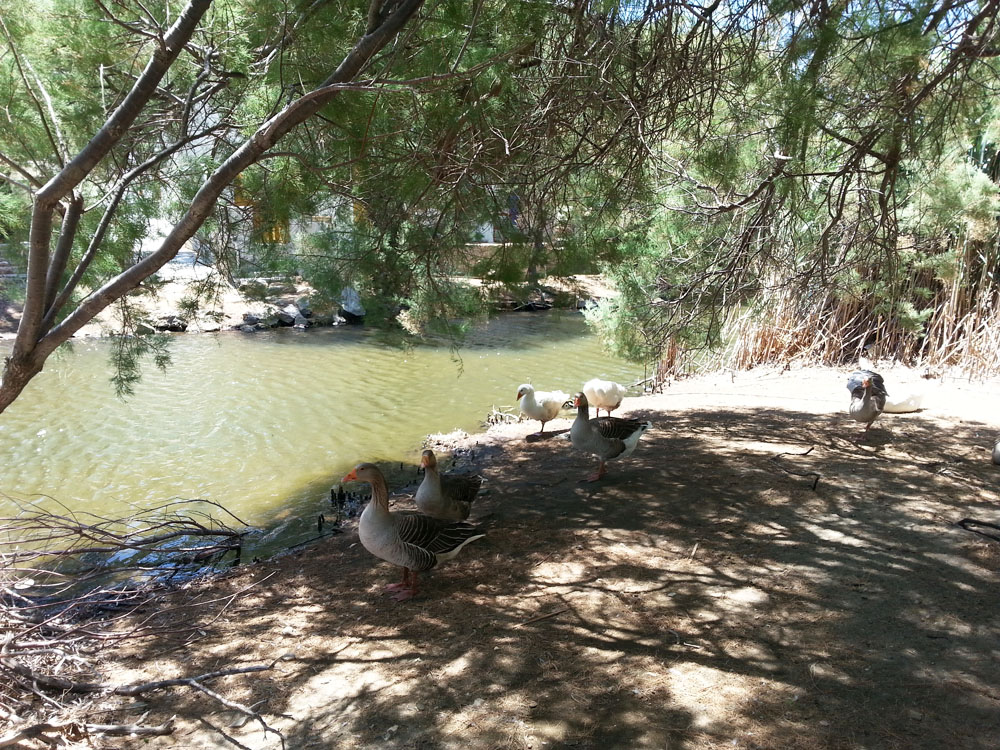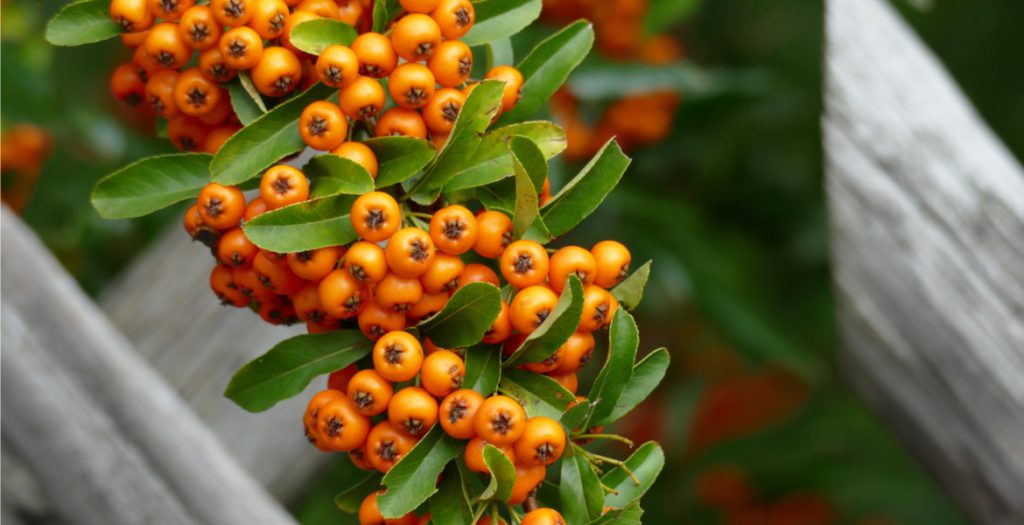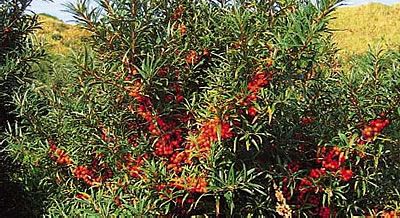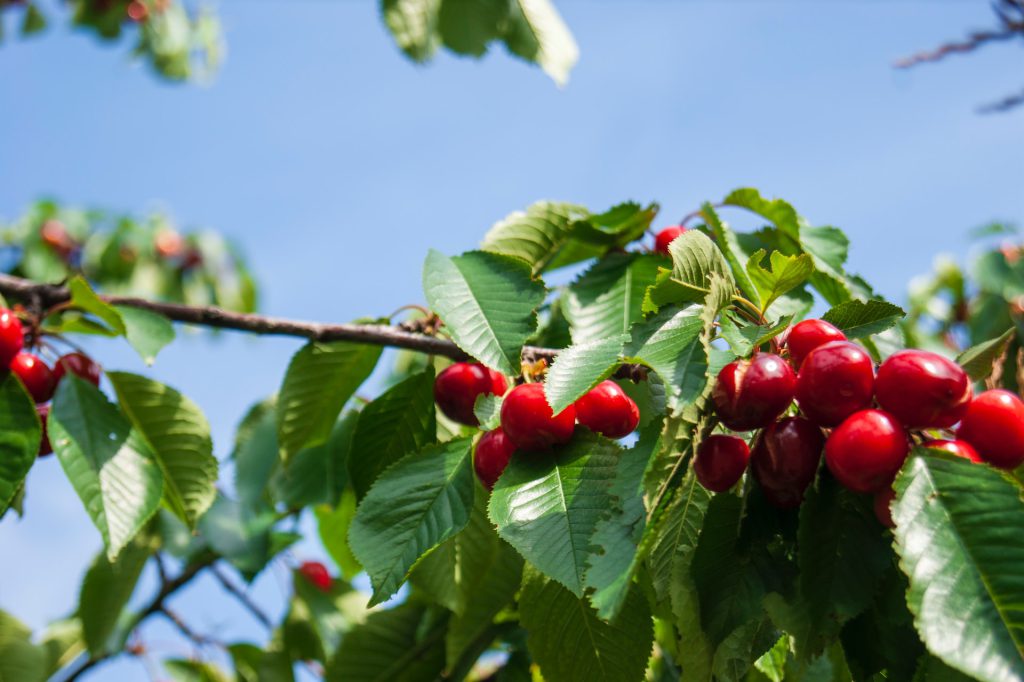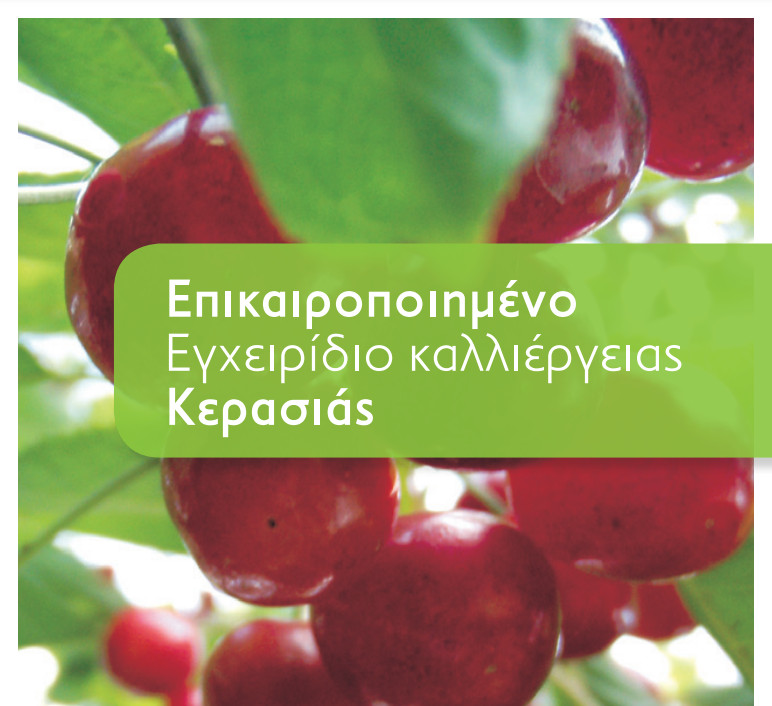What does Tinos Greek island have to do with cultivations? Tinos is one of the most beautiful islands I have visited. A Greek island of endless art exhibits and a testimony to the love of its inhabitants. I don’t say “museum”, but a showroom, because “museum” refers to the past, the old, the forgotten. But Tinos is alive and glorifies the present.
In Tinos island you will find cultivations in two places. In places where there is water. In places where it is dry, without water.
The island, from end to end, is filled with terraces that create small flat places on slopes. A terrace is a flat space between two dry stone walls.
Dry stone painted with lime
The dry stone walls are the way the locals chose to take advantage of the sloping slopes of the island. The dry stone walls are small “dams” that hold back the soil. They create steps on a steep slope. Each step is a terrace. The dry stone walls are the only way that the island’s slopes can be cultivated. The material of construction of the dry stones is slate stones without binder. The stones were collected by the farmers from their fields.
We visited Tinos at the end of May 2017. We stayed at the Anthea Hotel next to the beach of Agios Fokas and very close to Tinos Town.
Anthea Hotel in Chora of Tinos next to the beach of Agios Fokas
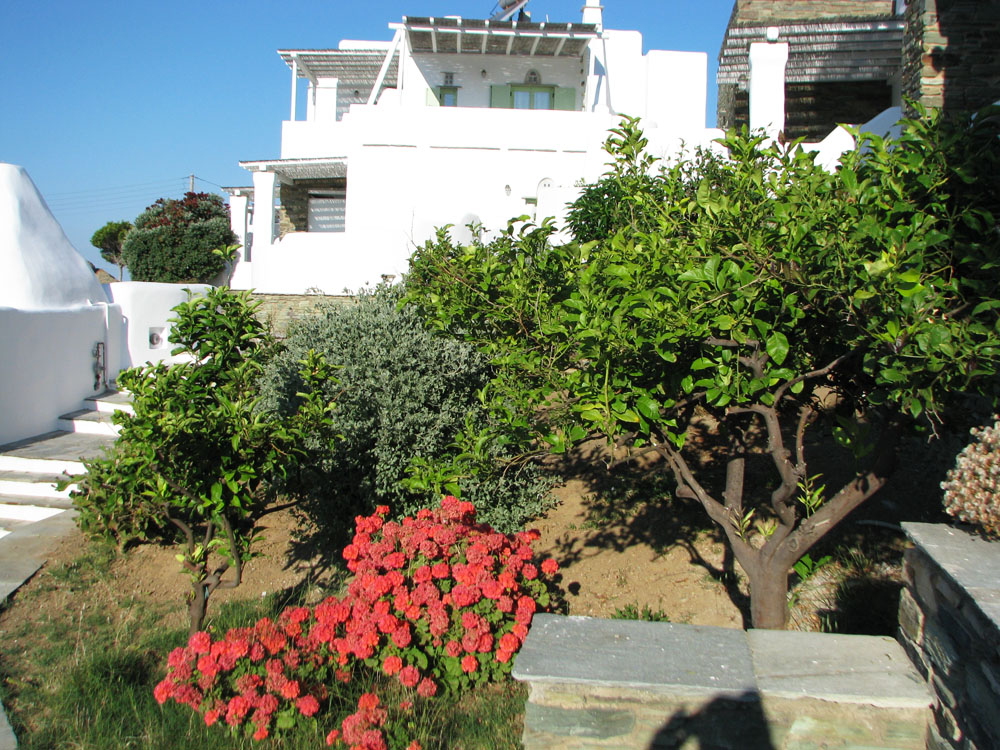
The hotel is in harmony with the environment. Inside the hotel there are gardens
Tarambados
Tarambados is a village near the centre of Tinos. It is famous for the dovecotes that are located around it.
Residence in Tarambados
Dovecote in Tarambados
It is distinguished by the beautiful houses and the “signposts” made of carved stones and placed at key points. The signs show the places where the visitor can go from the point where they are located.
A stone sign in Tarampados bearing a map of the village
Stone sign in Tarampados. It shows us which directions we can follow
Coming out of the village and heading towards the dovecotes, we met Mr. George Rigas, carving his garden with a hoe.
Mr. George Rigas, resident and farmer in Tarambados, Tinos
His garden stood among the reeds, sheltered from the winds. A small flat place with rich dark soil.
Artichoke garden in Tarabados
To the left of the garden was a paved path leading to the spring from which garden was watered. Alongside the path, we came across other vegetable gardens.
Artichokes, potatoes, onions, zucchini, cucumbers and artichokes in Tarampados
In the gardens, we saw artichokes, potatoes, onions, pumpkins, cucumbers being grown.
Tatiana talks enthusiastically with Mr. George Rigas
Mr. George Rigas was very friendly with us and eager to answer any questions we had. For a while he became our informal guide. He told us about the work of the association responsible for the landscaping of Tarambados, the construction and care of the path, the unique stone signs in the village. On the occasion of a random question I asked, he told us about the many snakes, especially vipers, that the island of Tinos has.
After showing us around the springs that water his garden, showing and telling us about the dovecotes, he invited us to his house for coffee.
We willingly followed this very kind and hospitable man. Mr. Rigos is a typical example of the Tinian people.
Hospitable and kind, like all the Tinos residents we met. A truly positive experience.
So was Mr. Rigas’ wife, who despite the unexpected nature of our visit, kissed us with a local dessert and invited us for coffee. Thank you!
Kardiani
The village of Kardiani is a place not recommended for a visit by some tourist guides.
Kardiani as seen from the road that passes over it
But it is a place to visit because Kardiani is beautiful. As beautiful as the famous Tower.
Kardiani is located in the northwestern part of Tinos island and is built on a hillside. The provincial road passes over Kardiani. There are two entrances to the village. Both are roads with a steep slope.
The slopes of Kardiani are cultivated
Kardiani is built on a steep slope and a natural spring runs vertically through it.
On one side of the village there is the Orthodox church and on the other the Catholic church.

The alleys of Kardiani
The houses in Kardiani have doors and windows in different colours. We were impressed by the beauty and the touches of colour in unexpected places.
The traditional café “Dimitra” in Kardiani
In a central spot you will find two traditional cafes. A little further on you will see the square with plane trees.
The locals told us that Kardiani had 70 children at school. Today it has only 1 pupil. Most residents now only visit it in the summer.
The hanging gardens of Kardiani
Dry stone walls and terraces in Kardiani
Here too we found dry stone walls and terraces where olives, fruit trees, tomatoes and cucumbers are cultivated.
A vegetable patch in Kardiani
The inhabitants take advantage of the water from the springs and water their gardens.
Notice the palm leaves covering the irrigation channels
To reduce water evaporation, they place palm leaves in the irrigation channels between the plants.
Sculpture of the Virgin Mary and Christ above a spring in Kardiani
Pictures from Tinos
St George subduing the dragon. Sculpture by Kostas Tsoklis in the courtyard of the Tsoklis museum in the village of Kampos. Unfortunately this museum was also closed
Interesting sculpture in Kardiani
Artistic Park “Spirit – Art – Labor”
Monument dedicated to the anonymous quarryman and to Halepas and Skalkotas outside the villages of Mamados and Marlas
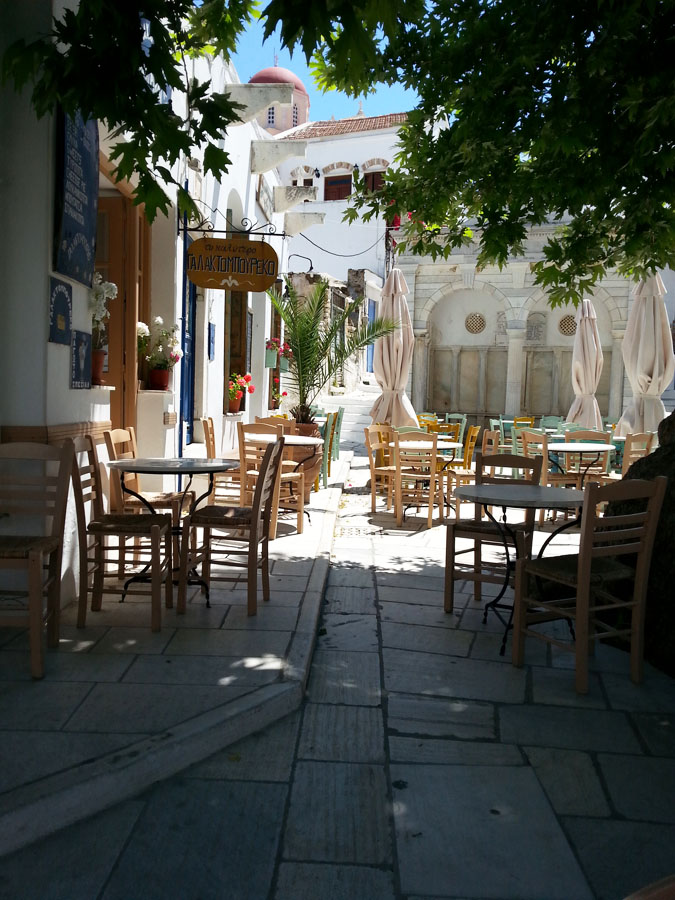
The square of the village of Pyrgos with the characteristic over-aged plane tree
Special plant in a clay pot
Beautiful house in Pyrgos
Dedicated to wine. “… The merry and turbulent divine… the orchestrator of drunkenness and tragedy…”. Outside a house in the Tower of Tinos
Above the inscription is the figure of Dionysus
Another wonderful sculpture in a house in the Tower of Tinos
The inscription outside this house reminds us that it was built in 1774
Ducks and geese near the beach of Rochari
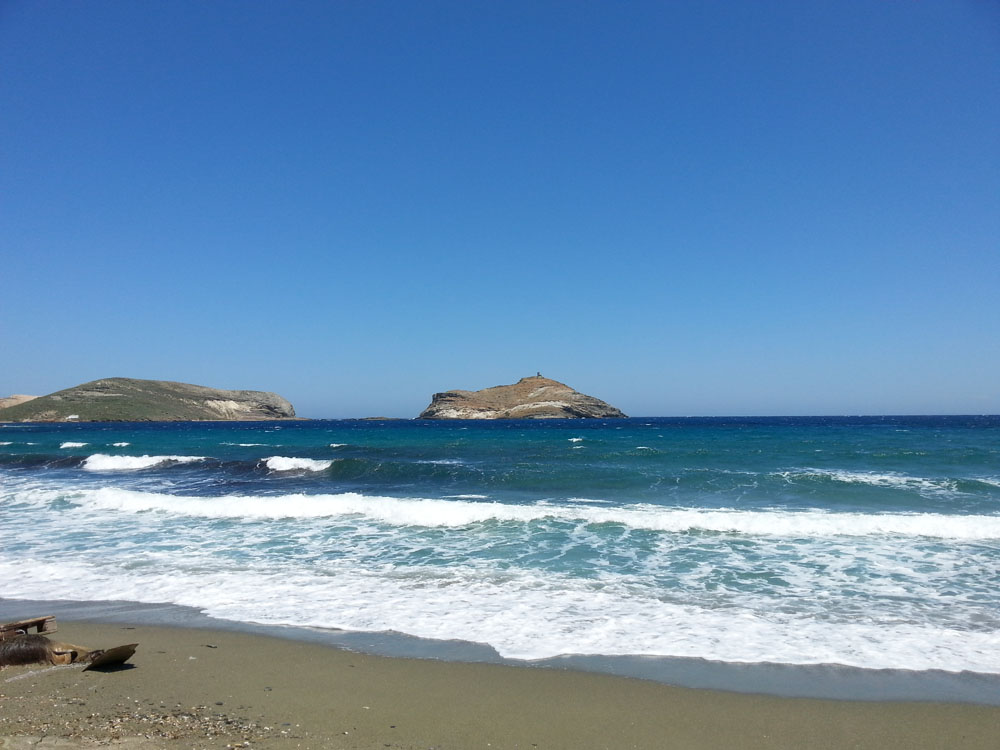
Agriculture in Tinos
I borrowed this text written by Mr. Mantos Villas, agronomist of the Tinos Agricultural Society, concerning agriculture in Tinos. Unfortunately the date of writing is not mentioned. Source: http://tinos.biz/deltio_tipou153.html
The island of Tinos has always been an agricultural island. Until a few decades ago, the agricultural activities of the people of Tinos remained largely similar to those of much earlier times. For example, the ancient hesiodion plough that was used to pull the animals was still in wide use as well as many other tasks such as threshing with animals etc.
The rapid introduction of machines (water pumps, tractors, etc.) in agriculture in the last 30-40 years seemed to give another dimension to the agricultural practice and would give a new impetus to the Tinians to work their land, which did not happen. The reason, in my opinion, is the rapid and unprecedented growth of the construction sector due to the island’s shift to tourism.
In recent decades, Tinos has been built from end to end and this reconstruction required labour, which was easily found by potential farmers, because of the better income that the building trade provided. At the same time, another part of the potential farmers turned to the tourist professions or preferred to study or work in any other field than agriculture, which led most of these young people to settle outside Tinos.
Reconstruction in every part of the Tinian countryside had other negative effects on agriculture and livestock farming on the island, since it tied up agricultural land, used the island’s underground water for the new housing needs it created, and in many cases created a conflict of interests between farmers and settlers, usually to the detriment of the former.
Thus, throughout the previous period, Tinos found itself without new farmers, who were presumably the ones who would introduce the new, modern concept in agricultural practice.
In all the years before the building boom, Tinos, as the agricultural island that it was, produced a range of products that suited its soil and climate conditions. I remember a lot of grapes, a lot of barley, some legumes, mainly beans and chickpeas, vine leaves, figs, olives – oil (until 10 – 15 years ago there were 2 olive presses), lemons and of course in the meadow of Komi – Kallonis, in the gardens of the gullies all over the island and in the lowlands of Chora, all kinds of vegetables.
The livestock farming of Tinos was extensive, utilizing every kind of nomia that grew on the island, and produced part of the required fodder on the spot, especially by cultivating cereals and legumes. Many will remember two threshing bands ploughing the island in order to get in time to thresh the entire harvest.
Greece’s entry into the EU brought subsidies in agriculture, but also quotas in the production of some products, e.g. milk. In Tinos, subsidies have only benefited the sheep and goat sector at the expense of all other sectors of production.
The shift of our farmers to sheep and goats because of the subsidies led to a number of other side effects, such as the abandonment of the cultivation of fields and their conversion into pastures, the abandonment of cow farming, the problems in the cultivation of vineyards and trees, the destruction of the walls of the terraces, the disappearance of bush vegetation and, above all, the creation of semi-wild herds which have escaped the supervision of the farmers and are a scourge of the Tinian countryside.
The introduction of quotas – negative subsidies, I might add – which were intended to reduce the production of certain products, also led to a gradual decline in cow farming.
So while in 1981 the cooperative cheese dairy was operating, which used cow’s milk and required some kind of subsidy for milk production, at the same time milk production was, I would say, persecuted by the state, which, following EEC directives aimed at reducing milk production in the EU, introduced a quota on cow’s milk. In other words, you were not allowed to produce more milk than a certain amount allocated to you. There was no question of subsidising it either, of course. At the same time, in order to finish milk production, a subsidy for beef cows was introduced, with the only eligibility criterion for subsidies being that the cow should not be sold.
All the above factors therefore led to a decline in Tinian agriculture.
The exception to this decline over the years has been a few important events that I believe will contribute to its future restart. I refer first to the establishment and operation of the beekeeping cooperative thanks to the initiative of the enlightened and idealistic friend, the late Alexandros Sklavos. This cooperative gave a good boost to Tinian beekeeping, mainly by taking advantage of relevant programmes. Thus, it managed to achieve the modernisation of the beekeeping units with all kinds of machinery and equipment.
Thanks to certain programmes, some small agricultural processing plants were also set up, the cheese dairy was partially modernised, and a modern slaughterhouse and oil mill were built and put into operation. A private company has also cultivated a significant area of abandoned vineyards, which have already entered their productive phase.
Today I estimate that Tinian agriculture is at its lowest point, with few farmers and even fewer entrepreneurial farmers. The problems are many, especially the lack of human resources due to the fact that agriculture in Tinos does not yield significantly or yields much less than other sectors.
Other general or individual problems of agriculture and beekeeping on the island of Tinos, which I have identified very briefly, are the following:
- Competition between farming and off-farming
- The lack of water for agriculture. The existing dam of Livada and the one under discussion in Griza, together with the one in Vaqueta, should provide water for agriculture
- Competition for water for agriculture and other uses. Particularly with the constant drilling of boreholes by institutions and non-farmers, it has dried up every natural source that used to water our small gardens and orchards of our gullies
- The legalization – licensing of existing stables and the spatial restriction of the creation of new stables only in a specific area
- The marketing within Tinos of imported products, which are baptised ‘Tinian’. This causes competition and makes it impossible to sell within Tinos the agricultural and livestock products produced on the island. A better functioning of the market is required in order to protect both Tinian products and consumers
- The overpopulation of stray semi-feral goats and sheep
- Overgrazing and the burning of bee plants (reducing the bee population)
- The lack of land reclamation – drainage – irrigation works in the ‘Livadi’ of Komi – Kallonis, and other necessary infrastructure works (roads, electrification, etc.) throughout the island
- Uncontrolled disposal of urban waste water
- The non-subsidisation of the transport of fertilisers and agricultural products exported from the island, e.g. cheese, artichokes, livestock, in line with the subsidised transport of animal feed to the island
- The exclusion of farmers from financial programmes due to numerous conditions and bureaucratic requirements. It is characteristic that no farmer has benefited from the farm modernisation programmes, while the new farmers who have joined the young farmers’ programme can probably be counted on the fingers of one hand. Farmers and farmers need to be supported through what I would call ‘small improvement rafts’, without the multitude of bureaucratic restrictions
- The lack of a dedicated office or service on Tinos for the primary sector to provide support to both farmers and operators. This office, properly staffed, would help in advising farmers, identifying problems, finding solutions, drafting proposals to local bodies, monitoring the implementation of specific actions, introducing and supporting new proposals
- The lack of the necessary staff in the services according to their workload. (e.g. a veterinarian in Tinos)
- The total lack of education – training of farmers
- The failure to resolve the problem of the continuous water supply and the disposal of waste water from the cooperative cheese dairy and the olive oil mill
Proposals for the immediate future, which may help to restart something, since the crisis is leading things towards involvement in agriculture and a return to the village:
- in principle, implementation or resolution of all or some of the above problems.
- putting into practice the notorious, constitutionally enshrined ‘insularity’ in the agricultural sector as well. It is not possible to equate the island farmer with the farmer of the Thessalian plain or the cheese factory of Tinos with the dairy company DODONI as far as the requirements of the legislation are concerned. On small islands, only the minimum requirements should be established as regards the establishment and operation of farms, processing or other facilities (land use, waste, raw material, quotas, permits for stables, utilisation of slaughterhouse by-products, etc.)
- intensifying the link between primary agricultural production and tourism. There must be no hotel or other catering establishment that does not use agricultural products.
- the creation of producer groups by product, with the aim of reducing production costs, improving product quality and increasing standardisation, with the ultimate aim of boosting the income of farmers and stockbreeders. This is to some extent what the beekeeping cooperative is doing.
- cow’s milk is currently a product that has a guaranteed supply due to the operation of the cheese dairy. So cow rearing combined with the self-production of at least part of the fodder is, I think, a proposal. In other islands next to us there are even large cow farming units, e.g. Mykonos, Naxos, Syros.
- efforts to collectively market Tinian meat, especially lamb and goat meat.
- i believe that there is potential for some form of pig farming to produce the famous Tinian sausages and louzas which are now made from non-Tinian meat.
- there is clearly scope for continued viticulture with Tinos grape varieties. This includes the possibility of legal bottling and, I believe, export of raki.
- further development, after some study and organisation, of the cultivation of specific outdoor or greenhouse vegetables which could be selected as locally promoted. E.g. artichoke or lemon in the past, which I believe can be re-cultivated.
- after the recent operation of the olive mill and the planting of many olive trees in recent years, further development of olive cultivation could be done with standardization and marketing of the oil.
- study of possible new crops, -but coming from the old ones- such as dried figs, some legumes or aromatic plants. For example: fava beans in Santorini are doing well, or figs in Evia
- why shouldn’t Tinos produce barley or vetch again, as it used to? Today we import all the barley we sow from Paros and Lemnos. Islands the size of Tinos, are they not?
Epilogue
Tinos island is a place to explore when visiting Greece.
Known mainly for the temple of the Virgin Mary, it has much to offer to all visitors. It is located very close to Athens.
It is worth visiting and discovering!
Tags: CULTIVATION • ISLAND • TINOS ISLAND

